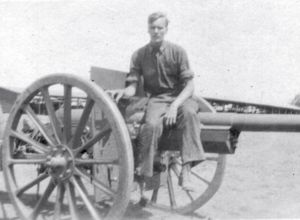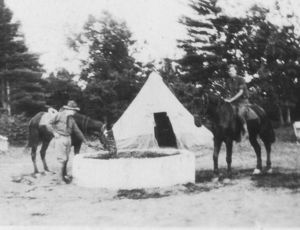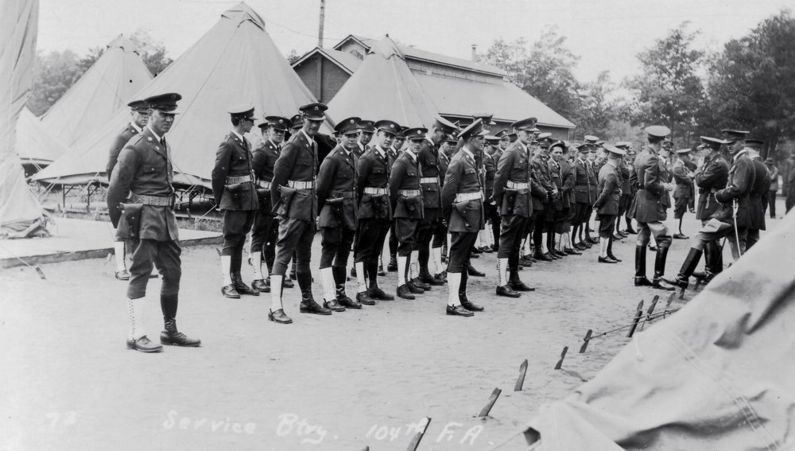Fort Drum (2)
|
Fort Drum (2) (1908-Present) - First established in 1908 as Pine Camp to train northeastern National Guard and Reserve units. Located in Jefferson County, New York. Active military reservation. Also known as Camp Drum (2) and Camp Hughes (1). Early HistoryIn 1908, BG Frederick Dent Grant, son of General Ulysses S. Grant, was sent here with 2,000 regulars and 8,000 militia. He found Pine Plains to be an ideal place to train troops. The following year money was allocated to purchase the land and summer training continued here through the years. The camp's first introduction to the national spotlight came in 1935 when the largest peacetime maneuvers were held on Pine Plains and surrounding farm lands. Thirty-six thousand, five hundred soldiers came from throughout the Northeast to take part in the exercise. Some soldiers traveled by trains which arrived in town every 15 minutes, coming from as far away as Buffalo and New York City. For 36 hours, young men from offices, factories, and farms marched, attacked and defended in tactical exercises on the 100-miles the Army had leased for its war games. The maneuvers were judged to be most successful and the War Department purchased another 9,000 acres of land. World War II (1941-1945)With the outbreak of World War II, the area now known as Pine Camp was selected for a major expansion and an additional 75,000 acres of land was purchased. With that purchase, 525 local families were displaced. Five entire villages were eliminated, while others were reduced from one-third to one-half their size. By Labor Day 1941, 100 tracts of land were taken over. Three thousand buildings, including 24 schools, 6 churches and a post office were abandoned. Contractors then went to work, and in a period of 10 months at a cost of $20 million, an entire city was built to house the divisions scheduled to train here. Eight hundred buildings were constructed; 240 barracks, 84 mess halls, 86 storehouses, 58 warehouses, 27 officers' quarters, 22 headquarters buildings, and 99 recreational buildings as well as guardhouses and a hospital. Construction workers paid the price, as the winter of 1941-42 was one of the coldest in North Country history. The three divisions to train at Pine Camp were General George S. Patton's 4th Armored Division (Gen. Creighton Abrams was a battalion commander here at the time), the 45th Infantry Division and the 5th Armored Division. The post also served as a prisoner of war camp. Of those prisoners who died here, one Italian and six Germans are still buried in the Sheepfold Cemetery near Remington Pond. Cold War (1947–1991)Pine Camp became Camp Drum (2) in 1951, named after Lt. Gen. Hugh A. Drum who commanded the First Army during World War II. During and after the Korean Conflict a number of units were stationed and trained here to take advantage of the terrain and climate. The post was designated Fort Drum in 1974 and a permanent garrison was assigned. In April 1980, B Company, 76th Engineer Battalion (Combat Heavy) was reassigned here from Fort Meade, Md. It was followed by the rest of the battalion, less Company D, three years later. In January 1984, the Department of the Army announced it was studying selected Army posts to house a new light infantry division. On September 11, 1984, the announcement was made that Fort Drum would be the new home of the 10th Light Infantry Division. The first division troops arrived at Fort Drum on December 3, 1984 and the unit was officially activated on February 13, 1985. The name was changed to the 10th Mountain Division (Light Infantry) at that time. The division reached full strength in 1989. Between 1986 and 1992, 130 new buildings, 35 miles of roads, and 4,272 sets of family housing units were built at a cost of $1.3 billion. The mission of the 10th Mountain Division (LI) is to be manned and trained to deploy rapidly by air, sea, and land anywhere in the world, prepared to fight upon arrival and win. On June 4, 1985, the identity of a Roundout Brigade was announced. The brigade was composed of New York Army National Guard battalions from central and northern New York under the 27th Infantry Brigade. On June 28, 1985, the 76th Engineer Battalion was inactivated.
Current StatusActive military installation. Home of the 10th Mountain Division, Light Infantry.
Sources:
Links: Visited: 25 Jul 2012
|



